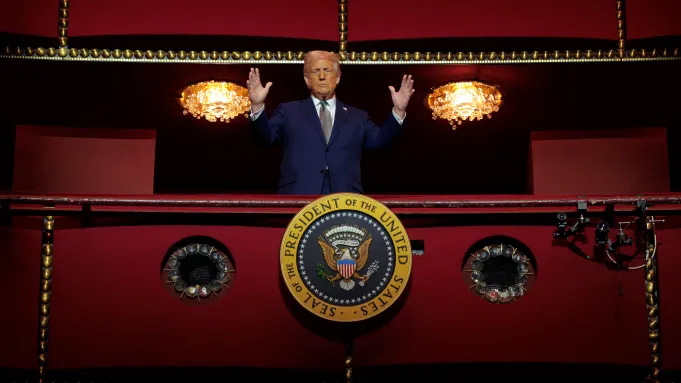Despite the Kennedy Center stage belonging to the cast of “Les Miserábles” when the warhorse musical opened there last week, Donald Trump, watching from the presidential box, was the star of the evening as he made his public debut as chairman of the venerable arts institution.
Applause and cheers filled the auditorium as Trump made his entrance to a venue stacked with cabinet members (RFK Jr., Pam Bondi, Scott Bessent) and high-profile cheerleaders (right wing provocateur Laura Loomer; Fox News’ Maria Bartiromo, now a board member at the Center). The president’s supporters were not quite drowned out by a steady hum of boos from his detractors. A coterie of drag queens received a lukewarm reception. Their presence was a modest act of protest against the administration’s vow to rid the Kennedy Center of subversive performers.
The night culminated months of high drama around Trump’s “hostile takeover” of the Kennedy Center. It did not go unnoticed that he watched a musical about an uprising against the state during the French Revolution just as national guardsmen and marines, at Trump’s behest, attempted to quash protests in Los Angeles over the White House’s renewed deportation push there.
Beyond that coincidence of timing, the evening again thrust into the spotlight a central controversy of Trump’s second term: a crackdown on dissenting expression that has convulsed American cultural organizations and universities and evoked similar suppression in plainly authoritarian regimes throughout recent history.
The skirmish began just after the inauguration. Trump in February named himself Kennedy Center chairman, axed 18 members of the board of directors and replaced President Deborah Rutter with acolyte and special envoy Richard Grenell.
Stated reasons for the move included Rutter’s financial mismanagement (she in fact increased the Center’s endowment by over 50% between 2014 and 2023) and a Kennedy Center Honors intent on rewarding “radical left lunatics” (a phrase Trump reused at the premiere to describe LA protestors). Dissatisfaction broadly stemmed from a tilt toward unpatriotic identity politics onstage and off. The Center’s social impact team promptly lost all its funding during the reorganization.
Trump mandarins have been upfront about the need for a cultural purge. Project 25 delineates a neat schism between “woke revolutionaries and those who believe in the ideals of the American revolution.” Conservative activist Christopher Rufo wrote in a Wall Street Journal op-ed that in order to “put a stake through the heart of woke,” it behooved the White House to “retake control of museums.”
Other possible motivations left unsaid by the administration include the potent message sent by commandeering a cultural jewel a mile away from the White House, in the nation’s capital. There’s also the unique sway the federal government holds over the Kennedy Center, which as a bureau of the Smithsonian Institution operates as a public-private partnership that last year relied on the federal government for 16% of its $268 million budget.
Response among prominent artists was swift. Grand opera diva Renée Fleming, “Hamilton” creator Lin-Manuel Miranda and actress-comedian Issa Rae pulled out of planned performances at the venue. New management scrapped a Pride celebration featuring the Gay Men’s Chorus of Washington, D.C. and a run of “Eureka Day,” a play about vaccine skepticism.
Other shows must, and will, go on. But Trump’s Kennedy Center takeover is not performative, and it’s especially ominous taken in tandem with other retributional moves against institutions at the heart of American intellectual and cultural life.
The administration’s salvo against Harvard has stripped the school of billions of dollars in research grants. Trump is trying to rid it of international students in response to what the White House argues is a lax response to antisemitism and pervasive leftist thought conformity.
A crackdown on those unaffiliated with world-famous universities and without boldface names has led to international travelers, among them prominent intellectuals, being detained at airports over social media posts critical of the administration.
The disdainful strikes against elite universities and cultural lodestars share an impetus to quell expression, academic or artistic, counter to the dictates of the government.
The historical precedents are chilling. As David Remnick wrote in the New Yorker, it is the “reflexive urge of autocrats everywhere” to “police the past,” including artistic legacies. Mao replaced the “Four Olds,” or antagonistic art forms, with flagrant propaganda. Stalin sent writers and artists outside the sole permitted artistic purview of Socialist Realism to gulags. Berlin’s Kreuzberg neighborhood became an international hotbed of radical protest art by dint of being an island of FRG liberty surrounded during the Cold War by repressed GDR districts.
At the Kennedy Center, the immediate pain has been acute. Single-ticket sales fell 50% in April and May versus 2024. The news was even more bleak for subscriptions, a critical economic pillar to performing arts venues: revenues plunged 82% for theater and 57% for dance.
The growing protests against the Trump administration have reached the Kennedy Center, led by students from neighboring Georgetown. Declining finances and alienated performers make clear that the 54-year-old institution’s survival is at stake. Let’s hope, and fight, for a comeback in the next act.

